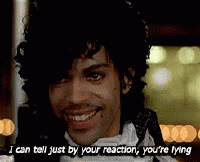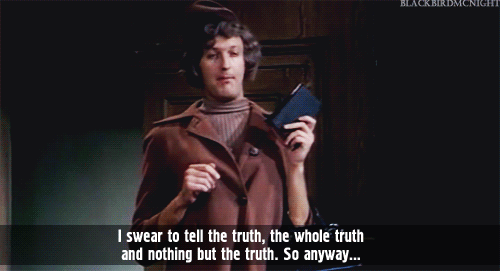How To Tell If Someone Is Lying To You, According To Experts
Knowing how to detect lies is totally like a superpower.
Did you know that according to experts, we're lied to anywhere between 10 to 200 times on any given day! :O
These same experts have been trained in techniques that help in figuring out when someone is lying. Aptly known as liespotting, it involves paying attention to elements such as speech patterns, body language and facial expressions when someone is talking.
These techniques are used in a variety of scenarios, including during interrogations and court trials. But they're also applicable in your daily life.
So the next time you suspect someone might be lying to you, experts recommend looking out for these signs:
1. Using non-contracted denials and distancing language
When determined to lie, people are more likely to use formal language instead of informal language which means that they will use the full form of words instead of contractions.
They will also unconsciously try to distance themselves from the subject they are lying about by using words that show how they are far removed from it.
Example: "I did not (instead of didn't) go out with that woman (instead of her name)."
2. Setting honesty disclaimers in place before telling their story
People sometimes preface their lies with statements like "well to tell you the truth" or "if I'm being honest" because they think it will help convince people of their honesty but this is actually a red flag for experts.
Disclaimers like that are known as qualifying language and using it shows that someone is trying to overly emphasise that they're telling the truth. This shouldn't be necessary if you actually are being honest.
3. Repeating themselves
Liars often say the same words and phrases over and over again throughout the course of the conversation, and may even repeat the entirety of a question you asked back at you.
This happens for two reasons. Firstly, they are trying to convince both you and themselves of something that didn't happen so the repetition serves to validate the lie in their minds. And secondly, it is a way to buy themselves time to plan what to say.
4. Including a little too much detail
When someone is telling you something that includes way too much unnecessary details, especially in irrelevant places of the story, you should probably take what they're saying with a grain of salt.
The tendency to overly flesh out their stories is done in hopes of making it seem more realistic, distract you from the main point by talking too much, or make themselves more believable by being "open".
5. Freezing up and staying completely still
We think that liars fidget all the time out of nervousness and anxiety, but you should also be cautious when someone is too still.
It's natural for us to move around in subtle and unconscious ways when having normal conversations. For example, you may shift your weight from one foot to another or make slight changes in your posture.
So it's often a warning sign when someone goes rigid, completely freezes up, and makes little to no movement whatsoever, especially in their upper bodies. This is because of our bodies' natural 'fight or flight' response. In this case, the body is in 'fight' mode, preparing itself for a possible confrontation.
6. Maintaining eye contact
Another common misconception is that liars will not look you in the eyes. While this is true, more experienced liars will do the exact opposite try to manipulate, intimidate, and control you by maintaining eye contact. Their gaze will usually be cold, focused and steady.
Also keep an eye on how often someone blinks. Not blinking at regular intervals or blinking too fast are both signs that something is up.
7. Putting on a fake smile
Liars use smiles to make themselves seem friendly and open which makes it more likely for others to trust them. To truly tell whether someone's smile is real or fake, pay attention to the eyes. Only a genuine smile will cause the tiny lines around your eyes (crows feet) to appear as these muscles cannot be consciously contracted.
8. The following all indicate that someone is feeling uncomfortable and nervous:
- Shuffling their feet or pointing their feet towards the exit - This is the body's unconscious response that means the person in question wants to escape the situation. They are displaying their desire to walk away.
- Covering vulnerable body parts - This usually happens when the conversation starts heading in a direction that may unravel their lie or when you say something that hits a nerve. The liar may instinctively try to protect themselves by covering their head, throat, chest, or abdomen.
- Touching or covering their mouth - By showing signs of cutting off communication, this means that the person doesn't want to talk about something or is reluctant to tell the truth.
- Putting barrier objects between themselves and the person they're talking to - Eliminating space and literally placing obstacles in the way helps them feel safe and protected.
9. Imagine that you're trying to figure out who took the RM50 you accidentally left on your table. Here's how an honest person VS a deceptive person would act when you question them:
An honest person will be:
- Cooperative
- Openly show that they're on your side (both in terms of spoken and body language)
- Enthusiastic, willing, and helpful in helping you find out what happened
- Willing to brainstorm suspects and provide details
- If you suspect or accuse them, they will be angry throughout the conversation
- More likely to recommend strict punishment
A deceptive person will be:
- Withdrawn
- May look down, lower their voice, and display jerky movements
- Include too much detail in their story and only tell it in strict chronological order
- If you suspect or accuse them, they will display anger in flashes
- More likely to recommend lenient punishment
10. Displaying gestures that don't match what they're saying
This can be one of the most difficult things to spot as the gestures are often subtle and don't last long. It happens because people will rehearse their story over and over again when planning to lie but rarely do they also rehearse the gestures that go along with it.
Some common instances you can look out for include shaking one's head indicating "no" but saying "yes", and slightly shrugging the shoulders despite telling a very convincing story.
11. Failing to control their expressions
Unlike with gestures, liars will usually practice their expressions to make sure they're displaying the correct and relevant emotions. But there are times when their true feelings leak through. This is even more difficult to spot than gestures as they usually only flash by.
The most prevalent one is known as 'duping delight', whereby someone lets a smile slip while lying about something they did, indicating their joy in getting away with it.











